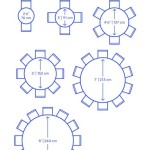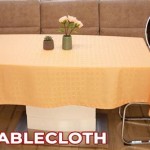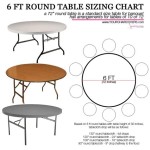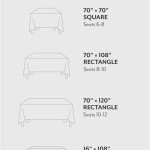Selecting the Correct Size Round Rug Under a Table
Selecting the appropriate rug size for placement under a table, particularly a round rug, is a crucial element of interior design. The dimensions of the rug significantly impact the room's overall aesthetics, functionality, and perceived space. A rug that is too small can make a room appear disjointed and cramped, while a rug that is too large can overwhelm the space and negate the visual impact of the furniture. Therefore, understanding the principles of rug sizing and how they apply to round rugs is essential for achieving a harmonious and visually appealing interior.
The purpose of a rug under a table extends beyond mere decoration; it also provides several practical benefits. A rug anchors the furniture, defining the designated area within an open floor plan. It adds a layer of warmth and comfort underfoot, especially in rooms with hard flooring like wood, tile, or laminate. Furthermore, a rug helps to absorb sound, reducing echoes and contributing to a quieter and more comfortable environment. When it comes to selecting a round rug placement under a table, many factors such as table size, room size and shape, traffic and design style have to be considered.
Considering Table Size and Shape
The size and shape of the table are the primary determinants of the ideal round rug size. The general guideline is to ensure that the rug extends far enough beyond the table's edges to accommodate chairs, even when they are pulled out. This prevents chairs from getting caught on the rug's edge and provides a comfortable seating experience. When selecting a round rug, the diameter of the rug should be the main point of attention, as the diameter will define the rugs area coverage.
For a round dining table, a common suggestion is to choose a rug that is at least 4 feet larger in diameter than the table itself. This allows for approximately 2 feet of rug extending beyond the table's edge on all sides, sufficient for chairs to remain fully on the rug even when occupied. For example, if you have a 4-foot diameter round table, the rug should ideally be at least 8 feet in diameter. This recommendation accounts for the space needed for comfortable chair movement and visual balance.
However, these numbers need to be adjusted when considering the table styles. For tables with pedestal bases, the rug dimensioning can be calculated using the base's dimension as the starting point. Tables with legs that extend further from the top or tables with unique shapes may require additional consideration. The goal is to ensure that the rug adequately covers the area where chairs will be located, allowing easy movement and preventing instability.
When dealing with tables that are not perfectly round, such as oval or oblong shapes, the longest dimension should be used as the basis for determining the rug size. The rug should be large enough to extend beyond the table's longest side by at least 2 feet, ensuring adequate coverage for seating. In such cases, a round rug might still be suitable if it complements the overall room design and provides sufficient coverage, but an oval or rectangular rug may fit the shape of the table and room shapes better, providing a more visually cohesive and functional solution.
Sometimes the table size can be deceiving. For example, a small bistro table meant for two can look awkward on an oversized rug. In such a case, a rug that is just slightly larger than the table's footprint might be more appropriate, providing a subtle anchor without overwhelming the space. Conversely, a large dining table in a formal dining can look stunted and dwarfed by a small rug. In either case, it is important to think about the table's intended function and its visual presence in the room.
Assessing Room Size and Shape
The overall dimensions and shape of the room are also a crucial factor in determining the appropriate size for a round rug under a table. A rug that is proportionally too small or too large can disrupt the harmony of the room and create an unbalanced aesthetic. The room's size dictates the maximum rug size which is the amount of the space the rug is filling, while the room's shape is a crucial reference on how the rug should be placed.
In a small room, a large rug can overwhelm the space and make it feel even smaller. In such cases, it is preferable to opt for a smaller rug that defines the table area without dominating the entire floor. A good approach is to leave at least 12 to 18 inches of exposed flooring around the perimeter of the rug, creating a visual buffer and preventing the room from feeling cramped. Leaving space around the rug creates a visual break and allows the flooring to contribute to the room's overall design.
Conversely, in a large room, a small rug can appear insignificant and fail to anchor the furniture effectively. In larger spaces, it's important to choose a rug that is substantial enough to create a defined zone and visually connect the table with the surrounding elements. A large rug can help to fill the space and create a sense of warmth and cohesion. In such cases, the rug should extend well beyond the table's edges, providing ample space for chairs and creating a visually pleasing arrangement.
The shape of the room is also a factor in rug selection. In a square or rectangular room, a round rug can provide a nice contrast to the room's angular lines, softening the overall aesthetic and adding a touch of visual interest. However, in a room with unconventional shapes or multiple angles, a round rug may not be the most effective choice. It's important to consider how the rug interacts with the room's architecture and whether it complements or clashes with the existing lines and angles. In such cases, a custom-shaped rug might be a better solution, providing a tailored fit that enhances the room's unique features.
Furthermore, the placement of the rug within the room should be carefully considered. It's important to ensure that the rug is centered under the table and that it aligns with other key architectural elements, such as doorways, windows, or fireplaces. This creates a sense of order and balance, contributing to a more harmonious and visually pleasing interior. If the rug is misaligned or off-center, it can create a sense of unease and disrupt the room's overall aesthetic.
Considering Traffic and Functionality
Beyond aesthetics and room size, the level of foot traffic and the intended use of the table area are critical considerations in selecting the appropriate rug size. A rug placed in a high-traffic area needs to be durable and easy to clean, while also providing adequate coverage to protect the flooring beneath. The rugs used in dining rooms should be able to handle spills and stains.
In a dining area, where chairs are frequently pulled out and pushed in, it's essential to choose a rug that is large enough to accommodate this movement. The rug should extend far enough beyond the table's edge to ensure that the chairs remain fully on the rug even when occupied, preventing them from getting caught on the edge. This not only enhances comfort but also protects the flooring from scratches and wear. The rug’s pile height is also to be considered in dining areas.
For areas with heavy foot traffic, such as entryways or hallways, a larger rug is generally preferable. A larger rug provides more coverage, protecting the flooring from wear and tear and reducing the risk of slips and falls. It also helps to trap dirt and debris, preventing it from being tracked throughout the house. If the rug is too small, it may become a tripping hazard and fail to provide adequate protection for the flooring.
The rug's material and construction are also important considerations when evaluating its suitability for high-traffic areas. Durable materials like wool or synthetic fibers are generally preferred, as they can withstand heavy use and resist stains. Rugs with a low pile height are also easier to clean and maintain, making them a practical choice for busy areas. The rug material will greatly affect the cleaning maintenance of the room as spills are expected when the rug is used underneath the table.
Additionally, the rug's backing should be considered. A non-slip rug pad is recommended to prevent the rug from shifting or sliding, especially on hard flooring surfaces. This adds an extra layer of safety and helps to prolong the life of the rug. The rug pad also provides additional cushioning and insulation, enhancing comfort underfoot.
In summary, selecting the correct size round rug for placement under a table requires careful consideration of several factors, including the table's size and shape, the room's dimensions, and the level of foot traffic. By taking these factors into account, it's possible to choose a rug that not only enhances the room's aesthetic appeal but also provides practical benefits and enhances the overall functionality of the space. A well-chosen rug can transform a room, adding warmth, comfort, and style. A properly sized rug will not only create a visually pleasing and harmonious interior, but is also durable enough to endure the daily tear and wear of the furniture.

Rules Of Thumb For Rugs Under Round Dining Tables Inspiration

Rules Of Thumb For Rugs Under Round Dining Tables Inspiration

N Handmade Natural Round Jute Rug Bedside Circle New Home Gift Boho Decor Patio Rustic Table

Rules Of Thumb For Rugs Under Round Dining Tables Inspiration

Round Rug Size Guide For 36 42 48 54 60 72 Inch Tables Rugs Direct

Rug Size Guide Ballard Designs

Round Rug Size Guide For 36 42 48 54 60 72 Inch Tables Rugs Direct

Rules Of Thumb For Rugs Under Round Dining Tables Inspiration

Rug Size Guide Ballard Designs

6 Rules For Choosing A Dining Room Rug Pretty Souces Stonegable
Related Posts








